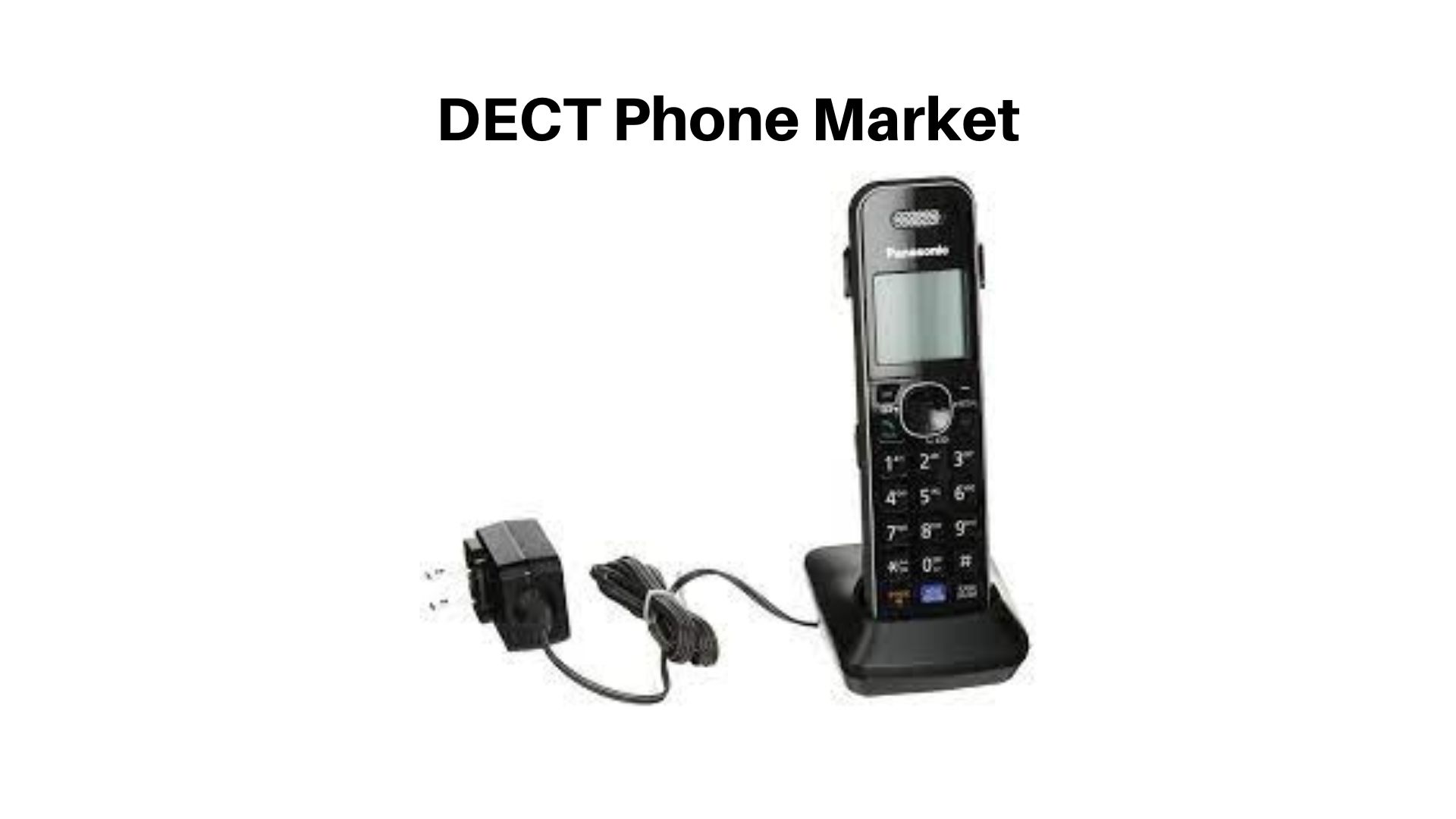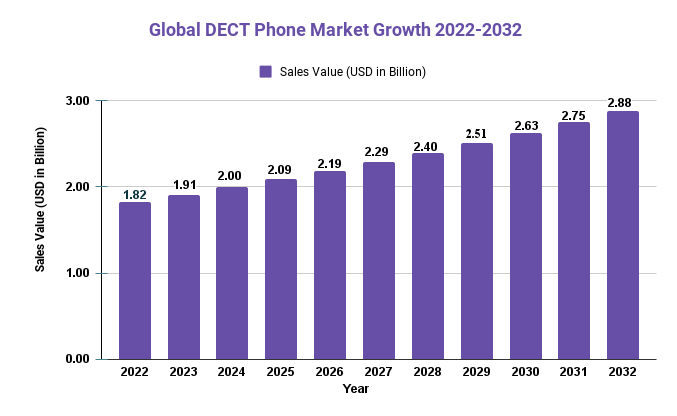DECT Phone Market Size Will Hit USD 2.88 billion in 2032

Page Contents
Market Overview
Published Via 11Press: The DECT phone market is a niche segment within the telecoms industry that primarily serves residential and small business customers. DECT (Digital Enhanced Cordless Telecommunications) phones are cordless systems operating on the DECT standard, providing higher quality sound and greater range than traditional analog cordless phones.
According to Market.us' report, the global DECT phone market size was valued at USD 1.82 billion in 2022 and is forecasted to expand at a compound annual growth rate (CAGR) of 4.7% from 2022 until 2032.
The growth is primarily attributed to increasing demand for wireless communication devices, advances in DECT phone systems, and the rising popularity of smart home automation.
We Have Recent Updates on the Market in Sample Copy@ https://market.us/report/dect-phone-market/request-sample

Regional Snapshot
- Europe: Europe holds a substantial share of the global DECT phone market. This growth is being fuelled by Europe's high adoption rate for DECT technology as well as an uptick in smart home automation projects. Major players such as Philips Electronics, Gigaset Communications, and Panasonic Company are all active participants in this space.
- North America: The DECT phone market in North America is well-established and highly saturated. Reputable firms such as Motorola Solutions and VTech Holdings Ltd dominate the region. Regional DECT phone providers may experience new growth potential due to the expanding smart home automation trend and growing use of cordless phones in residential settings.
- Europe: Europe holds a significant share of the global DECT telephone market due to its high technology adoption and rises in smart home automation. Major companies such as Philips Electronics and Gigaset Communications are located here.
- North America: North America's DECT phone market is highly saturated and well-established. VTech Holdings Ltd and Motorola Solutions are the two dominant players in this region. However, with the growing smart home automation trend and increased use of cordless phones within residential settings, regional DECT phone providers could potentially see new growth opportunities present themselves.
Market Dynamics
Drivers
- Growing Demand for Cordless Phones: Cordless phones provide convenience and mobility, which has seen a marked growth in demand for DECT (Digital Earpiece Communications Technology).
- Technological Advancements: Thanks to advances in technology, DECT phones have become more affordable and user-friendly, with improved battery life as well.
- Smart Home Market Growth: Smart homes are becoming more commonplace, and DECT phones have become the go-to for homeowners looking to integrate their phones with their smart home systems.
- Aging Population: As the population ages, there is an increasing need for user-friendly devices that offer large displays with legible text. DECT phones with larger screens and straightforward user interfaces are ideal for this demographic.
- Business Applications: DECT phones are becoming more and more commonplace in small businesses, offering dependable, cost-effective communication with employees and customers.
- Increased Access to DECT-Based IoT Devices: As more IoT devices adopt the DECT standard, demand for DECT phones has grown as they can seamlessly integrate with these gadgets.
Restraints
- Competition from Other Communication Technologies: DECT phones are becoming increasingly popular, but they must compete against other wireless communication technologies like Wi-Fi calling, mobile phones, and VoIP.
- Security Concerns: DECT phones are susceptible to eavesdropping and other security risks, which may deter some users from using them – particularly those who need to communicate sensitive data.
- Limited Range: While DECT phones are designed to offer a good range, they may not be ideal for larger homes or offices, which could limit their appeal.
- Declining Landline Usage: The trend toward declining landline usage could limit demand for DECT phones, particularly in regions where mobile phones have become the predominant communication technology.
- High Cost of Some DECT Phones: While DECT phones tend to be affordable, some high-end models can be quite pricey, which may limit their appeal for some consumers.
- Lack of Interoperability: Unfortunately, there is an absence of interoperability between different brands of DECT phones, making it difficult for consumers to switch between them or use different DECT-based devices together.
Opportunities
The rising popularity of smart home devices such as thermostats, lighting, and security systems presents DECT phones with an opportunity to integrate with these items and offer a convenient wireless communication solution.
- Adoption of DECT 6.0 Technology: DECT phone manufacturers now have an opportunity to differentiate their products and attract higher-end customers by adopting DECT 6.0 technology, which offers the superior sound quality, a longer range, and enhanced security.
- Growing demand for affordable communication solutions: DECT phones are often more affordable than mobile phones and other wireless communication technologies, making them an attractive option for consumers looking for affordable communication solutions.
- Expansion into Emerging Markets: The DECT phone market has immense potential for expansion in emerging countries, where landlines and wired communication systems are less common and mobile phones can be expensive.
- Integration with Business Communication Systems: DECT phones can be integrated with business communication systems, such as PBX systems, making them an attractive option for small businesses and remote workers who require a dependable yet cost-effective communication solution.
- Development of New Use Cases: DECT phones offer the potential to be utilized in creative and innovative ways, such as in healthcare settings or outdoor communication in remote locations.
View Detailed TOC of the Report | https://market.us/report/dect-phone-market/table-of-content/
Challenges
- DECT phone market faces intense competition from other communication technologies: The DECT phone market is facing fierce competition from wireless communication technologies such as Wi-Fi calling, mobile phones, and VoIP. These offerings offer similar features and functionalities which may be more appealing to some users.
- Rapidly shifting consumer preferences: As consumer tastes and behaviors continue to shift, DECT phone manufacturers may struggle to stay abreast of these changes. This could result in a loss of market share or diminishing relevance.
- Security Concerns: DECT phones are vulnerable to eavesdropping and other security risks, which may deter some users from using them, particularly those who need to securely communicate sensitive data.
- Limited Interoperability: Due to a lack of interoperability between different brands of DECT phones and devices, consumers may find it difficult to switch between brands or use different DECT-based devices together.
- Declining Landline Usage: The trend toward declining landline usage could limit demand for DECT phones, especially in regions where mobile phones have become the predominant communication technology.
- Regulatory Challenges: Alterations in regulations and policies related to wireless communication technologies could adversely impact the DECT phone market, creating additional obstacles to entry or expansion.
Key Market Segments
Type
- DECT Phone
- DECT 6.0 Phone
Application
- Home
- Offices
Key Market Players
- Panasonic
- Gigaset
- Philips
- Vtech
- Uniden
- Motorola
- AT&T
- NEC
- Clarity
- TCL
- Spectralink Corporation
- Yealink
- Grandstream Networks
- Polycom
- Orchid
- AZTECH
Report Scope
| Report Attribute | Details |
| The market size value in 2022 | USD 1.82 Bn |
| Revenue forecast by 2032 | USD 2.88 Bn |
| Growth Rate | CAGR Of 4.7% |
| Regions Covered | North America, Europe, Asia Pacific, Latin America, and Middle East & Africa, and Rest of the World |
| Historical Years | 2017-2022 |
| Base Year | 2022 |
| Estimated Year | 2023 |
| Short-Term Projection Year | 2028 |
| Long-Term Projected Year | 2032 |
Recent Developments
- May 2020: Spectralink Corporation has launched a virtual IP-DECT (VIP-DECT) server one solution to enable large enterprises to deploy, manage and flexibly scale their DECT mobility solutions in an efficient way.
- January 2020: Yealink Inc. has announced the launch of DECT based W80B IP-multi-cell system for the SMME business. It offers unified mobility through large places and delivers a consistent, clear, and high-quality audio experience.
Frequently Asked Question
Q: What is the current market size for the DECT Phone Market?
A: According to a report by Market.us, the DECT Phone Market was valued at USD 1.82 billion in 2022 and is expected to reach USD 2.88 billion by 2032, growing at a CAGR of 4.7% during the forecast period.
Q: What are the key segments of the DECT Phone Market?
A: The DECT Phone Market can be segmented based on Type (DECT Phone, DECT 6.0 Phone), By Application (Home, Offices), and geography (North America, Europe, Asia-Pacific, Latin America, and Middle East & Africa).
Q: Who are the key players in the DECT Phone Market?
A: Some of the key players in the DECT Phone Market include Panasonic, Gigaset, Philips, Vtech, Uniden, Motorola, AT&T, NEC, Clarity, TCL, Spectralink Corporation, Yealink, Grandstream Networks, Polycom, Orchid, AZTECH.
The team behind market.us, marketresearch.biz, market.biz and more. Our purpose is to keep our customers ahead of the game with regard to the markets. They may fluctuate up or down, but we will help you to stay ahead of the curve in these market fluctuations. Our consistent growth and ability to deliver in-depth analyses and market insight has engaged genuine market players. They have faith in us to offer the data and information they require to make balanced and decisive marketing decisions.



